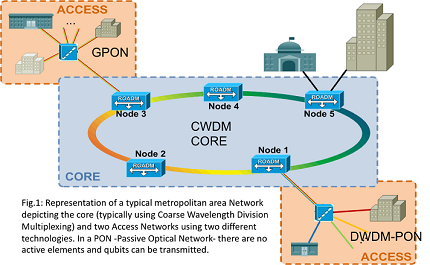Research areas
Quantum key distribution
Quantum Metropolitan area network.
One of the main research areas of the group is the integration of Quantum communications in telecommunications networks. The group has also participated in standardization work at ETSI (European Telecommunications Standard Institute). The research has been done building several networks together with Telefónica Research and Development. Considering the limited reach of quantum key distribution, the starting point was a metropolitan area network with the typical structure of core and access and the usual technologies: Coarse wavelength division multiplexing in the core ring and GPON in the access, as depicted in Fig. 1.

First Generation Network: QKD in the Core and GPON access network of a metro area network. Compatibility with classical equipment and communications studies (2009-12). [more ...]
Second Generation Network: Maximizing the number of users in a standard metro area network for quantum usage. Entanglement distribution in networks (2012-15). [more ...]
Third Generation Network: The objective of this network is more ambitious and the effort is now to demonstrate the capability of QKD to integrate in novel network and security infrastructures without restrictions covering a full telco metro beyond metro area. Obviously, the physical layer limitations are still there, hence the maximum distance and noise limits apply and trusted nodes have to be considered. The new network paradigms used are SDN (Software Defined Networking) and the associated NFV (Network Function Virtualization). [more ...]
Fourth Generation Network (2019-present), The Madrid Quantum Network has currently 13 links. The network is a real world one in the sense that all the network is in production facilities and that most of the nodes are being used simultanously for classical communications, including the fiber. This is not an ad hoc network builf for quantum purposes. As a result, this presents the same challenges that a commercial deployment of QKD technologies would need to overcome, making for a realistic testbed. Distances and losses are also representative of a typical metropolitan area network, ranging from 2 to about 40 km and from 3 to 14 dB, respectively (when all losses, not only the fibre is taken into account). Distances and losses (only fiber) are quoted in the figure. The purplelines (connecting to UAH) are under comissioning. The red ring in the center is the old Madrid Quantum Network installed in Telefónica premises. It is interesting to note that some nodes host special installations that are of particular interest, like IMDEA Networks (IMDEA-NW) which hosts a Telefónica 5G lab. [more ...]
More work on QKD network integration
Multiuser secure quantum communications over standard optical networks:
QKD over standard metropolitan and passive optical networks based on wavelength-division multiplexing [Ciurana et al, 2014
 ], or considering a post-processing step [Martinez-Mateo et al., 2014
], or considering a post-processing step [Martinez-Mateo et al., 2014  ].
].Entanglement distribution in optical networks using wavelength-division multiplexing schemes [Ciurana et al, 2015
 ].
].Secure network coding in the context of QKD: weakly trusted repeaters [Elkouss et al., 2013
 ].
].
QKD in next generation network paradigms
Bidirectional integration of QKD systems/networks in software networks: (i) Integration of QKD systems securing future network management and operations in software defined networking and network functions virtualisation architectures. (ii) New applications and service chaining involving QKD systems for secure transactions. (iii) Control plane enabling flexible QKD networks. This work is being carried out in the third generation network.
QKD postprocessing
Shortly presented below, our main contributions to the field of information reconciliation (error correction) in the context of secret-key agreement: efficient and high-speed information reconciliation methods proposed for QKD.
Efficient one-way information reconciliation for discrete variable QKD using rate-adaptive low-density parity-check (LDPC) codes [Elkouss et al., 2011
 ].
].Efficient two-ways information reconciliation for discrete variable QKD using short block-length LDPC codes and an incremental redundancy hybrid ARQ scheme [Martinez-Mateo et al., 2012
 ], and an optimized version of Cascade [Martinez-Mateo et al., 2015
], and an optimized version of Cascade [Martinez-Mateo et al., 2015  ].
].High speed information reconciliation for discrete variable QKD using short block-length quasi-cyclic LDPC codes [Martinez-Mateo et al., 2013
 ].
].Efficient one-way information reconciliation for continuous variable QKD using non-binary LDPC codes defined over a power-of-two finite field [Pacher et al., 2016
 ].
].

